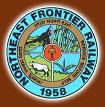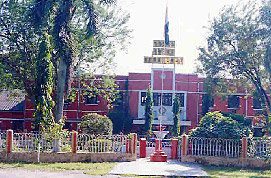 The Northeast Frontier Railway abbreviated as N F Railway is one of the 16 railway zones in India. Headquartered in Maligaon, Guwahati in the state of Assam it is responsible for rail operations in the entire Northeast and parts of West Bengal and Bihar. It is divided into 5 divisions:
The Northeast Frontier Railway abbreviated as N F Railway is one of the 16 railway zones in India. Headquartered in Maligaon, Guwahati in the state of Assam it is responsible for rail operations in the entire Northeast and parts of West Bengal and Bihar. It is divided into 5 divisions:
1. Tinsukia Railway Division
2. Lumding Railway Division
3. Rangiya Railway Division
4. Alipurdaur Railway Division
5. Katihar Railway Division
Each of these divisions is headed by a Divisional Railway Manager, a Senior Administrative Grade officer of the rank of Joint Secretary to Government of India.
About Us
The Northeast Frontier (NF) Railway has its historical roots in the former Assam Railways & Trading Company, Assam Bengal Railways, and Eastern Bengal Railways. The Assam Bengal Railways had the largest contribution to make in the formation of the present-day N. F. Railway.
Assam Railway P. Trading Company laid the first Railway line in Assam upto Makum collieries at Margherita in 1884. The Company also established the first passenger Railway system in Assam under the name Dibru Sadiya Railway. The Eastern Bengal Railway constructed the sections Haldibari – Siliguri, Barsoi – Kishanganj, Manihari – Katihar- Kasaba and opened these sometime before 1900. They expanded the network to other sections namely, Hasimara – Alipurduar, Gitaldaha Bamanhat, Golakganj – Amingaon, Rangiya – Rangapara & Dhubri during the period 1900-1911. The Assam Railway & Trading Company, the Eastern Bengal Railway and the Assam Bengal Railway which was also operating in the Barak Valley region, were merged during World War II and came to be known as the Bengal Assam Railway. Thereafter, some of the Company-owned Railways namely, Bengal Dooars Railway, Jorhaut Provincial Railway, Chaparmukh Silghat Railway and Katakhal Lalabazar Railway etc. were merged with the Bengal Assam Railway system.
With the partition of India in August 1947, the Bengal Assam Railway was bifurcated according to the political boundaries, leading to the formation of the Assam Railway with its headquarters at Pandu. In 1948 the Darjeeling – Himalayan Railway was also taken over by the Government of India and merged with Assam Railways.
The partition of the country and formation of the erstwhile East Pakistan (now Bangladesh) led to complete severance of communication with the State of Assam from the rest of India. It was restored with the completion of the Assam Rail Link Project in January 1950.
During the reorganisation of Railway zones in 1953, Assam Railway and Avadh – Tirhut Railway were merged to form the North Eastern Railway with headquarters at Gorakhpur. The N. F. Railway system was carved out of the North Eastern Railway on 15th January, 1958 and based at Maligaon, Guwahati at the foothill of Nilachal ‘Parbat’, the abode of Goddess Kamakhya.
N. F. Railway is the smallest of the 9 zones on the Indian Railways, but has the unique distinction of serving as many as ten States of the Indian Union, namely Arunachal Pradesh, Assam, Bihar, Manipur, Meghalaya, Mizoram. Nagaland, Sikkim, Tripura and West Bengal. Besides, it also serves as a rail-head for the Himalayan kingdoms of Nepal and Bhutan and provides interchange facilities with Bangladesh Railway.
History
Railway first entered Assam in 1881 when the Assam Railway and Trading Company began construction of a 65-Km long metre gauge line from Dibrugargh to Makum Collieries in Margherita for the sole purpose of transporting tea and coal. The year 1881 was a landmark year for railways in this region for yet another event and that was the famous Darjeeling Himalayan Railway with the legendary Toy Train was commissioned.
With the partition of India, the Bengal and Assam Railway had to be re-divided according to the political boundary. As a result of which the Assam Railway was formed and from August 1947, with headquarters at Pandu. To establish an all India rail route, the construction of the Assam Rail Link between Kishanganj and Fakiragram, 142 miles long project was started on a war footing on 26th January, 1948 and completed and opened in December 1949 within a record time. The first passenger train run on January26, 1950.
 On April14, 1952 with the regrouping of the Indian Railways, the entire Assam Railway system was amalgamated to from the North Eastern Railway with its HQ at Gorakhpur in UP. Carved out of the unbifurcated NER, the Northeast Frontier was formed in 15th January,1958 with the aim to give greater impetus to the development of the Northeast with its HQ at Maligaon.
On April14, 1952 with the regrouping of the Indian Railways, the entire Assam Railway system was amalgamated to from the North Eastern Railway with its HQ at Gorakhpur in UP. Carved out of the unbifurcated NER, the Northeast Frontier was formed in 15th January,1958 with the aim to give greater impetus to the development of the Northeast with its HQ at Maligaon.
The N.F.Railway in under the administrative charge of the General Manager, who reports to Railway Board assisted by heads of departments .It is divided into four divisions-Alipurduar division, Katihar division, Lumding division and Tinsukia division.
The N.F.Railway is the smallest railway in the country but the dedicated service of the railwaymen and the sincere desire to meet the special requirement of this region helped progressively to improve the performance of this railway. The N.F.Railway serves as many as ten states, besides providing interchange facility with Bangladesh and serves as railhead for Nepal and Bhutan.
During the last four-decade, we have been continuously striving towards overall upliftment of this region by taking up numerous projects and executing them successfully.
Construction of Saraighat Bridge, the first rail-cum-road bridge over river Brahmaputra was started on January1958. It was opened to goods traffic in Oct.1962. The then prime minister of India Late Pandit Jawaharlal Nehru opened passenger traffic on 7th June. The estimated cost of the bridge was Rs.10,65,16,891.00
With the completion of the Saraighat Bridge, a modern era of Rail Transport has dawned in Assam and Northeast India, opening a new horizon of progress and development
MORE ABOUT US
click above to know more
about north east frontier railway
Sponsored Links
